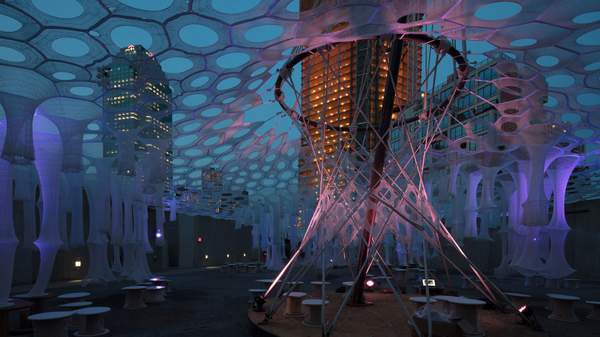Overview
For the next two months, visitors to MoMA PS1 in New York's Queens best start looking up. The gallery has just installed its latest installation, Lumen, which turns the venue's courtyard into a environmentally responsive, colour-changing wonderland.
Designed by Jenny Sabin Studio, winning The Museum of Modern Art and MoMA PS1's annual Young Architects Program, and on display until September 4, Lumen consists of cellular canopies made from textiles that react to conditions around them: light and heat, namely. As the environment changes — aka the weather gets gloomy, or day turns to night — so do the hues emitted by its digitally knitted fibres. If you've ever wondered what the '90s Hypercolor fad would look like if it was strung across the sky, this dreamy interactive piece provides the answer.
So, how does it work? Well, those fibres are solar-active and photo-luminescent. Almost a million metres of them have been turned into 250 hanging tubular structures, and paired with 100 robotically woven recycled spool stools, as well as a misting system that responds to visitors' proximity. The aim is to use insights and theories from biology, materials science, mathematics and engineering to create an adaptive piece of micro-climate-like architecture that behaves like an organism.
As Sabin describes, "by night, Lumen is knitted light, bathing visitors in a responsive glow of photo-luminescence; by day, Lumen offers succor from the summer heat, immersing participants in delicious ground clouds of cooling mist." She continues: "Lumen is a feminine form that offers luminous interiorities, informal networks, social fabrics, and fibrous assemblages that are pliable, transformative, and playful."
Via: Inhabitat. Images: Lumen by Jenny Sabin Studio for the Museum of Modern Art and MoMA PS1's Young Architects Program 2017. Courtesy MoMA PS1. Photo by Pablo Enriquez.
